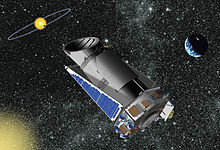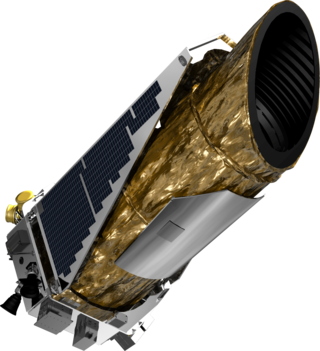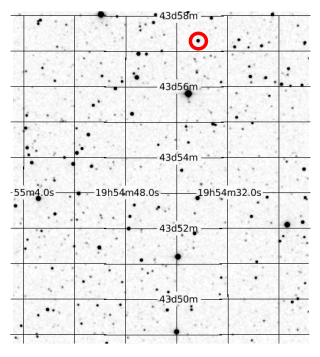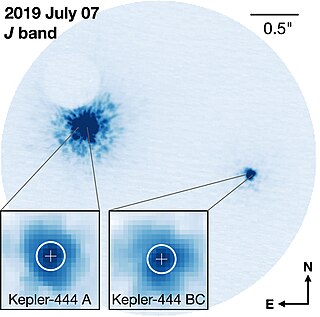
This is a list of unconfirmed exoplanets discovered or detected by the NASA Kepler mission (Kepler Candidates from the NASA Exoplanet Archive) that are potentially habitable. [1] [2] Those already confirmed are listed by their Kepler names in the list of potentially habitable exoplanets, and the data may differ when the planets are confirmed. Masses for a pure iron, rocky, and water composition are given for comparison purposes.
The planet candidate KOI-4878.01 could be one of the most Earth-like known planets in terms of size and stellar flux. [3] [4] [5] [6]
| Name | Star | Mass (ME) | Radius (R🜨) | Flux (F🜨) | Teq (K) | Period (days) | Distance (ly) |
|---|---|---|---|---|---|---|---|
| KOI-4878.01 [7] | F | 3.0 - 1.0 - 0.4 | 1.0 | 1.05 | 258 | 449.0 | 1075 |
| KOI-456.04 [8] | G | - | 1.91 | - | - | 378.4 | 3140 |
| KOI-3456.02 | F | 4.9 - 1.5 - 0.7 | 1.2 | 0.92 | 249 | 486.1 | 1460 |
| KOI-5737.01 | G | 7.7 - 2.2 - 1.0 | 1.3 | 0.99 | 254 | 376.2 | 1833 |
| KOI-5806.01 | G | 6.3 - 1.9 - 0.8 | 1.3 | 1.29 | 271 | 313.8 | 970 |
| KOI-5499.01 | G | 5.1 - 1.6 - 0.7 | 1.2 | 1.43 | 279 | 122.6 | 1965 |
| KOI-2194.03 | F | 10.8 - 2.9 - 1.2 | 1.4 | 0.78 | 239 | 445.2 | 1914 |
| KOI-6108.01 | G | 3.4 - 1.1 - 0.5 | 1.1 | 0.61 | 225 | 485.9 | 755 |
| KOI-5938.01 | F | 21.7 - 5.0 - 2.1 | 1.7 | 1.03 | 257 | 545.2 | 1597 |
| KOI-5087.01 | G | 15.5 - 3.9 - 1.6 | 1.6 | 0.71 | 234 | 651.1 | 1260 |
| KOI-5948.01 | G | 5.8 - 1.7 - 0.8 | 1.2 | 0.58 | 222 | 398.5 | 1427 |
| KOI-5176.01 | G | 6.3 - 1.9 - 0.8 | 1.3 | 1.72 | 292 | 215.7 | 1304 |
| KOI-5949.01 | F | 44.2 - 8.1 - 3.2 | 1.9 | 0.92 | 249 | 559.8 | 1873 |
| KOI-5506.01 | F | 18.6 - 4.5 - 1.9 | 1.6 | 0.66 | 230 | 641.6 | 2638 |
| KOI-6239.01 | G | 30.6 - 6.4 - 2.6 | 1.8 | 0.73 | 236 | 406.5 | 1743 |
| KOI-5888.01 | G | 38.5 - 7.4 - 3.0 | 1.8 | 1.32 | 273 | 190.9 | 2875 |
| KOI-5068.01 | F | 16.5 - 4.1 - 1.7 | 1.6 | 1.69 | 290 | 385.3 | 1740 |
| KOI-5541.01 | G | N/A - 11.2 - 4.3 | 2.0 | 0.93 | 250 | 339.6 | 2550 |
| KOI-5959.01 | G | 27.8 - 6.0 - 2.4 | 1.7 | 1.55 | 284 | 251.5 | 2451 |
| KOI-5236.01 [2] | F | 64.4 - 9.9 - 3.8 | 2.0 | 0.79 | 240 | 550.9 | 1605 |
| KOI-5819.01 | G | 5.9 - 1.8 - 0.8 | 1.2 | 0.48 | 212 | 381.4 | 1459 |
| KOI-5413.01 | G | 70.1 - 10.3 - 4.0 | 2.0 | 0.74 | 236 | 428.4 | 1882 |
| KOI-5202.01 [2] | F | 37.2 - 7.3 - 2.9 | 1.8 | 0.63 | 227 | 535.9 | 2865 |
| KOI-1871.01 [2] | K | N/A - 13.8 - 5.2 | 2.1 | 1.21 | 267 | 92.7 | 1169 |
| KOI-5653.01 | K | N/A - 10.7 - 4.1 | 2.0 | 0.68 | 231 | 188.7 | 1895 |
| KOI-5237.01 | G | 38.5 - 7.4 - 3.0 | 1.8 | 0.60 | 224 | 380.4 | 2761 |
| KOI-6151.01 | G | 8.7 - 2.5 - 1.1 | 1.4 | 0.47 | 211 | 431.8 | 1731 |
| KOI-5545.01 | G | 3.5 - 1.1 - 0.5 | 1.1 | 0.43 | 206 | 541.0 | 1379 |
| KOI-5592.01 | F | N/A - 18.5 - 6.7 | 2.3 | 0.81 | 241 | 482.5 | 3587 |
| KOI-4986.01 | G | 12.5 - 3.3 - 1.4 | 1.5 | 0.47 | 211 | 444.0 | 2112 |
| KOI-5796.01 | F | N/A - 18.5 - 6.7 | 2.3 | 0.78 | 239 | 495.9 | 3110 |
| KOI-5613.01 | G | N/A - 22.7 - 7.9 | 2.4 | 0.94 | 251 | 346.4 | 3972 |
| KOI-5810.01 | G | N/A - 16.8 - 6.1 | 2.2 | 1.41 | 278 | 425.6 | 2336 |
| KOI-5835.01 | F | N/A - 24.0 - 8.3 | 2.4 | 0.91 | 249 | 475.0 | 3791 |
| KOI-5290.01 | G | N/A - 11.6 - 4.4 | 2.1 | 0.61 | 225 | 435.5 | 3793 |
| KOI-4583.01 | G | N/A - 11.4 - 4.4 | 2.0 | 0.61 | 225 | 330.9 | 3127 |
| KOI-5869.01 | K | N/A - 23.2 - 8.1 | 2.4 | 1.21 | 267 | 114.4 | 2007 |
| KOI-3401.02 | G | N/A - 15.2 - 5.6 | 2.2 | 1.52 | 283 | 326.7 | 2697 |
| KOI-5657.01 | F | 70.1 - 10.3 - 4.0 | 2.0 | 1.74 | 293 | 284.7 | 2745 |
| KOI-4333.01 | F | N/A - 14.7 - 5.5 | 2.2 | 1.61 | 287 | 309.3 | 2583 |
| KOI-5874.01 | G | N/A - 15.5 - 5.7 | 2.2 | 1.65 | 289 | 287.3 | 1770 |
| KOI-5889.01 | F | N/A - 23.2 - 8.1 | 2.4 | 1.45 | 279 | 374.4 | 5030 |
| KOI-5135.01 | G | 70.1 - 10.3 - 4.0 | 2.0 | 0.53 | 217 | 314.8 | 2577 |
| KOI-5556.01 | G | 41.2 - 7.7 - 3.1 | 1.9 | 0.46 | 210 | 632.0 | 1459 |
| KOI-5798.01 | G | N/A - 10.9 - 4.2 | 2.0 | 0.48 | 212 | 318.3 | 2632 |
| KOI-5196.01 | F | N/A - 22.7 - 7.9 | 2.4 | 1.84 | 297 | 392.5 | 1424 |
| KOI-5924.01 | G | N/A - 26.4 - 9.0 | 2.5 | 0.54 | 218 | 291.3 | 2604 |
| KOI-3028.02 | G | N/A - 12.8 - 4.8 | 2.1 | 0.45 | 208 | 458.2 | 3759 |
| KOI-5398.01 | G | N/A - 12.6 - 4.8 | 2.1 | 0.43 | 206 | 551.2 | 2154 |
| KOI-4902.01 | K | 31.6 - 6.5 - 2.6 | 1.8 | 0.35 | 196 | 409.4 | 2012 |
| KOI-5749.01 | K | N/A - 18.8 - 6.8 | 2.3 | 0.41 | 204 | 282.0 | 1883 |
| KOI-4961.01 | K | N/A - 11.2 - 4.3 | 2.0 | 0.36 | 198 | 349.0 | 2048 |
| KOI-5829.01 | G | 61.9 - 9.7 - 3.8 | 2.0 | 0.35 | 196 | 583.9 | 2412 |
| KOI-2770.01 [2] | K | N/A - 18.8 - 6.8 | 2.3 | 0.39 | 201 | 205.4 | 1511 |
| KOI-5570.01 | G | N/A - 17.8 - 6.4 | 2.3 | 0.35 | 196 | 574.7 | 2236 |
| KOI-5649.01 | G | N/A - 19.2 - 6.9 | 2.3 | 0.29 | 187 | 426.9 | 1861 |
| KOI-6425.01 [2] | G | 18.7 - 4.5 - 1.9 | 1.6 | 0.68 | 231 | 521.1 | 2183 |
| KOI-6676.01 [2] | F | 32.6 - 6.7 - 2.7 | 1.8 | 1.18 | 266 | 439.2 | 2495 |
| KOI-7040.01 [2] | F | 14.8 - 3.8 - 1.6 | 1.5 | 0.48 | 212 | 502.2 | 2483 |
| KOI-7179.01 [1] [2] | G | 5.1 - 1.6 - 0.7 | 1.2 | 1.3 | 272.1 | 407.1 | 1807 |
| KOI-7223.01 [1] [2] | G | 21.7 - 5.0 - 2.1 | 1.7 | 0.57 | 221.5 | 317 | 1705 |
| KOI-7235.01 [1] [2] | G | 5.8 - 1.8 - 0.8 | 1.2 | 0.75 | 237.4 | 299.7 | 2006 |
| KOI-7345.01 [2] | F | N/A - 22.3 - 7.8 | 2.4 | 1.2 | 266 | 377.5 | 3748 |
| KOI-7470.01 [1] [2] | G | N/A - 10.5 - 4.1 | 2.0 | 0.60 | 225 | 392.5 | 1483 |
| KOI-7554.01 [2] | F | N/A - 12.1 - 4.6 | 2.1 | 1.13 | 263 | 482.6 | 3361 |
| KOI-7587.01 [1] [2] | G | N/A - 18.6 - 6.7 | 2.3 | 1.03 | 256.8 | 366 | 679 |
| EPIC 203823381.01 [2] | M | 0.8 - 0.3 - 0.1 | 0.7 | 0.40 | 203 | 8.3 | 10 |
| KOI-2124.01 [1] | K | - | 1 | - | 297 | 42 | - |
| KOI-7617.01 [1] | - | - | 0.63 | - | 342 | 13 | - |
| KOI-7923.01 [9] | - | - | 0.97 | - | - | 395 | - |
| KOI-4427.01 [1] [2] | M | 38.5 - 7.4 - 3.0 | 1.8 | 0.24 | 179 | 147.7 | 782 |
| KOI-7591.01 [2] | K | 7.2 - 2.1 - 0.9 | 1.3 | 0.33 | 193 | 328.3 | 1582 |
| KOI-6343.01 [2] | F | 47.4 - 8.4 - 3.3 | 1.9 | 0.61 | 225 | 569.5 | 2910 |
| KOI-5276.01 [2] | K | ? - 15.2 - 5.6 | 2.2 | 0.72 | 235 | 220.7 | 2728 |
| KOI-6734.01 [2] | G | ? - 13.1 - 4.9 | 2.1 | 0.50 | 214 | 498.3 | 3708 |
| KOI-7136.01 [2] | G | ? - 17.4 - 6.3 | 2.3 | 0.52 | 217 | 441.2 | 3654 |










